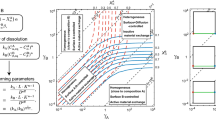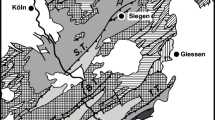Abstract
A general model has been developed to calculate changes of δ18O of minerals in addition to their composition and modal abundance in metamorphic systems. A complete set of differential equations can be written to describe any chemical system in terms of the variables dP, dT, dX, dM, and dδ18O (X, M, and δ18O refer to the chemical composition, number of moles, and oxygen isotope composition of each phase respectively). This set is composed of the differentials of five subsets of equations: (1) conditions of heterogeneous equilibrium; (2) compositional stoichiometry for each mineral; (3) mass balance for each oxide component; (4) oxygen isotope partitioning between phases; (5) conservation of the oxygen isotope ratio of the system. The variance of the complete set of equations is 2, and changes of δ18O, composition, and modal abundance for each mineral can be calculated for arbitrary changes of P and T. Applications to a typical pelitic bulk composition at amphibolite and lower granulite facies conditions suggest that for systems dominated by continuous reactions such as: (a) chlorite + quartz = garnet+H2O; (b) staurolite + biotite = garnet + muscovite + H2O; or (c) garnet + muscovite = sillimanite + biotite, isopleths of mineral δ18O are nearly independent of pressure, and have a spacing of about 0.1‰ per 10–20°C. For nearly discontinuous reactions such as: (d) garnet + chlorite + muscovite = biotite + staurolite+H2O; (e) staurolite + muscovite = biotite + aluminosilicate + garnet+H2O; or (f) muscovite + quartz = sillimanite + K-feldspar+H2O, isopleths of mineral δ18O have slopes more nearly parallel to endmember reaction boundaries and δ18O of phases can have a greater temperature dependence (e.g., 0.1‰ per 2°C for reaction d). This behavior results from relatively large amounts of reaction progress for small changes of P or T. However, the calculated exhaustion of a reactant within 0.1–5°C ensures that the predicted effects of such reactions on mineral δ18O will not exceed ∼0.25‰ for typical bulk compositions. Models that allow for fractional crystallization of garnet suggest that prograde garnet zoning in pelitic assemblages will be relatively smooth until staurolite becomes unstable. At higher temperatures, garnet may develop a step of as much as 0.6‰ in its core-rim zoning as a result of combined garnet resorption during the continuous reaction garnet + muscovite = sillimanite + biotite and repartitioning of the garnet rim composition to relatively heavy δ18O. The models are insensitive to the degree to which garnet fractionally crystallizes and to the isotope fractionation factors used; only extreme changes in modal abundance or bulk composition for a given mineral assemblage can produce significant changes in the predicted trends. In the absence of infiltration, isotopic shifts resulting from net transfer reactions for minerals in typical amphibolite, eclogite, and lower granulite facies metapelites and metabasites are inferred from the models to be ∼1‰ or less for ∼150°C of heating.
Similar content being viewed by others
References
Berman RG (1988) Internally-consistent thermodynamic data for minerals in the system Na2O-K2O-CaO-MgO-FeO-Fe2O3-Al2O3-SiO2-TiO2-H2O-CO2. J Petrol 29: 445–522
Bohlen SR, Boettcher AL (1981) Experimental investigations and geological applications of orthopyroxene geobarometry. Am Mineral 66: 951–964
Bottinga Y, Javoy M (1975) Oxygen isotope partitioning among the minerals in igneous and metamorphic rocks. Rev Geophys Space Phys 13: 401–418
Chamberlain CP, Conrad ME (1991) Oxygen isotope zoning in garnet Science 254: 403–406
Chamberlain CP, Ferry JM, Rumble D III, (1990) The effect of net-transfer reactions on the isotopic composition of minerals. Contrib Mineral Petrol 105: 322–336
Clayton RN, O'Neil JR, Mayeda TK (1972) Oxygen isotope exchange between quartz and water. J Geophys Res 77: 3057–3067
Coghlan RAN (1990) Studies in diffusional transport: grain boundary transport of oxygen in feldspars, diffusion of oxygen strontium and the REEs in garnet, and thermal histories of granitic intrusions in south-central Maine using oxygen isotopes. PhD Dissertation, Brown University
Garlick GD, Epstein S (1967) Oxygen isotope ratios in coexisting minerals of regionally metamorphosed rocks. Geochim Cosmochim Acta 31: 181–214
Haar L, Gallagher J, Kell GS (1979) Thermodynamic properties for fluid water. In: Straub J, Scheffler K (eds) Water and steam: their properties and current industrial applications. Proc 9th Int Conf Properties Steam. Pergamon Press, New York pp 69–82
Kohn MJ (1991) Studies of the metamorphism in west-central New Hampshire, U.S.A., and Tierra del Fuego, Chile. PhD Dissertation, Rensselaer Polytechnic Institute
Kohn MJ, (in press) Uncertainties in differential thermodynamic (Gibbs method) P-T paths. Contrib Mineral Petrol
Kohn MJ, Valley JW, Elsenheimer D, Spicuzza M (1992) Oxygen isotope zoning in garnet and staurolite from Tierra del Fuego, Chile: evidence for closed system mineral growth during regional metamorphism (abstract). Geol Soc Am Abstr Program 24: A250
Kohn MJ, Spear FS, Dalziel IWD (in press). Metamorphic P-T paths from the Cordillera Darwin, a core complex in Tierra del Fuego, Chile. J Petrol
Kretz R (1983) Symbols for rock-forming minerals. Am Mineral 68: 277–279
Matsuhisa Y, Goldsmith JR, Clayton RN (1979) Oxygen isotopic fractionation in the system quartz-albite-anorthite-water. Geochim Cosmochim Acta 43: 1131–1140
O'Neil JR, Taylor HP Jr (1967) The oxygen isotope and cation exchange chemistry of feldspars. Am Mineral 52: 1414–1437
O'Neil JR, Taylor HP Jr (1969) Oxygen isotope equilibrium between muscovite and water. J Geophys Res 74: 6012–6022
Prigogine I, Defay R (1954) Chemical thermodynamics. Longmans, Green and Co, London
Richter R, Hoernes S (1988) The application of the increment method in comparison with experimentally derived and calculated O-isotope fractionations. Chem Erde 48: 1–18
Rumble D III (1976) The use of mineral solid solutions to measure chemical potential gradients in rocks. Am Mineral 61: 1167–1174
Rumble D III (1982) Stable isotope fractionation during metamorphic devolatilization reactions. In: Ferry JM (ed) Characterization of metamorphism through mineral equilibria. (Reviews in Mineralogy 10) Mineral Soc Am Washington, D.C., pp 327–353
Spear FS (1988a) The Gibbs method and Duhem's theorem: the quantitative relationships among P, T, chemical potential, phase composition, and reaction progress in igneous and metamorphic systems. Contrib Mineral Petrol 99: 249–256
Spear FS (1988b) Metamorphic fractional crystallization and internal metasomatism by diffusional homogenization of zoned garnets. Contrib Mineral Petrol 99: 507–517
Spear FS (1989) Petrologic determination of metamorphic pressure-temperature-time paths. In: Spear FS, Peacock SM, Metamorphic pressure-temperature-time paths (Short course in geology 7) Am Geophys Union, pp 1–55
Spear FS, Ferry JM, Rumble D (1982) Analytical formulation of phase equilibria: the Gibbs method. In: Ferry JM (ed) Characterization of metamorphism through mineral equilibria. (Reviews in Mineralogy 10) Mineral Soc Am, Washington, D.C., pp 105–152
Spear FS, Kohn MJ, Florence FP, Menard T (1990) A model for garnet and plagioclase growth in pelitic schists: Implications for thermobarometry and P-T path determinations. J Metamorphic Geol 8: 683–696
Spear FS, Peacock SM, Kohn MJ, Florence FP, Menard T (1991) Computer programs for petrologic P-T-t paths calculations. Am Mineral 91: 2009–2012
Thompson JB Jr (1982) Reaction space: an algebraic and geometric approach. In: Ferry JM (ed) Characterization of metamorphism through mineral equilibria. (Reviews in Mineralogy 10). Mineral Soc Am Washington, D.C., pp 33–52
Wenner DB, Taylor HP Jr (1971) Temperatures of serpentinization of ultramafic rocks based on O18/O16 fractionation between coexisting serpentine and magnetite. Contrib Mineral Petrol 32: 165–185
Author information
Authors and Affiliations
Rights and permissions
About this article
Cite this article
Kohn, M.J. Modeling of prograde mineral δ18O changes in metamorphic systems. Contr. Mineral. and Petrol. 113, 249–261 (1993). https://doi.org/10.1007/BF00283232
Received:
Accepted:
Issue Date:
DOI: https://doi.org/10.1007/BF00283232




